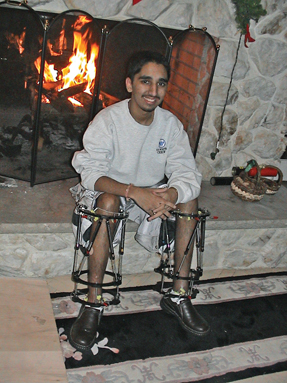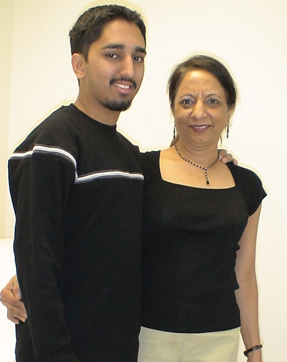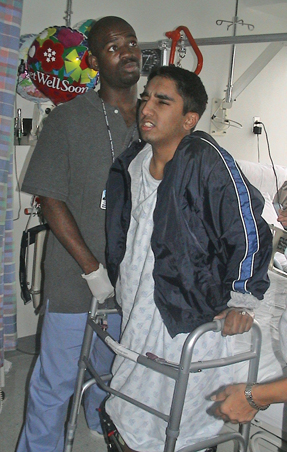|
At the tender age of 16, when most teenagers are fretting
over dates and pimples, Akash Shukla was devastated to learn from his
endocrinologist that he would not grow taller than 4 feet 11.5 inches. If he
had been living in India,
where the average height of men is 5 feet 5 inches, he may have been
indifferent, but growing up in New Jersey,
where the average man boasts a height of 5 feet 10 inches, Shukla was bothered
by his short stature. He felt people did not take him seriously and he did not
want to spend the rest of his life hearing jokes like, “Good things come in
small packages.” So instead of reconciling to his fate, as most people do, the
tenacious teenager decided to undergo a painful and expensive limb lengthening
surgical procedure to make him 2.5 inches taller.
 |
Limb lengthening involves cutting the patient’s leg with a
chisel and driving four to eight steel pins through them. This disturbing and
painful surgery did not deter Shukla. He was so determined to gain a couple of
inches that he even deferred his admission to Drexel
University in September 2004 to
focus single-mindedly on the surgery and the lengthy recovery thereafter.
After almost a year long turmoil, which Shukla describes as
“probably worse than giving birth to seven kids at a time,” he stands at a
proud 5 feet 2 inches. His says he turned his life around, as he gained not
only inches, but confidence and identity as well.
“I have gone from being known as short to being known as
Shukla. I am now free to engage the world as myself,” he says.
Shukla documents his unusual surgery in a book titled
Measure Of A Man, which he published in May 2009. He says: “Most people that go
through limb lengthening feel very uncomfortable about sharing their
experience. On the other hand, not only did I write a book, but agreed to
appear in newspaper articles and documentaries.”
Shukla’s candid and at times clinical account of his
experience captures the emotional and physical pain he endured: “A circular
frame is placed around the patient’s leg, below the knee. The frame is bolted
into the bone, right above the knee and above the ankle. Threaded screws go
through the skin and bone. The top and middle rings are connected by six
telescoping struts. Once the rings are securely attached to each leg, the
surgeon breaks the bone. After going home, the patient starts rotating each
strut a certain amount. This creates force that pushes the upper and lower
rings apart. As a result the broken bone pulls further apart and new bone grows
in its place.”
Shukla’s year-long painful recovery is reflected by the
chapter titles, such as “Pain is on the rise,” “The dark days are coming” and
“It is getting bleaker.” In later chapters, titled “God listened to our
prayers” and “The hard part is over,” the bleak sentiments shift as he relates
his recovery.
Shukla underscores how the support of his parents was
instrumental in both his decision to undertake the surgery and later as he struggled
to overcome the pain associated with it. He says they were all fully aware of
the dangers and rewards of the procedure, which is not covered by health
insurance and costs hundreds of thousands of dollars.
Four years after his surgery Shukla’s experience was covered
in a documentary Short & Male by Canadian filmmaker Howard Goldberg. Many
Indians, who may not empathize with Shukla’s obsession with his height, will
find in the film ways that Indian children growing up in the West combine the
practicality of their Western environment with their Eastern heritage.
Since the surgery, Shukla has a renewed confidence, doing
things that other boys his age take for granted, he says, like asking a date to
parties or locking eyes with a girl. He has also gained a perspective that few
his age can match: “I am better off than others and my problems are small in
this big world and I can fight this, because it’s all I want.”
He is now focused on his studies in Industrial Engineering
at NJIT in Newark, N.J.:
“After undergoing such a painful surgery, I thought, there shouldn’t be
anything I can’t do. I used this mentality to change my study habits. Before
the surgery, I used to be an average student. However, since then, I have
become a much better student and have made the Deans List for the last two
semesters.”
The 2.5 additional inches, Shukla says, has transformed his
character, as he weighs his future: “Once I get my undergraduate degree from
NJIT, I plan on pursing my masters degree in Engineering at NJIT. I also plan
to continue my journey towards becoming a more analytical problem solver. I
enjoy art, music and photography. Therefore, I would like to live life that is
a successful combination of technology and art.”
That’s no stretch for Akash Shukla.
|




